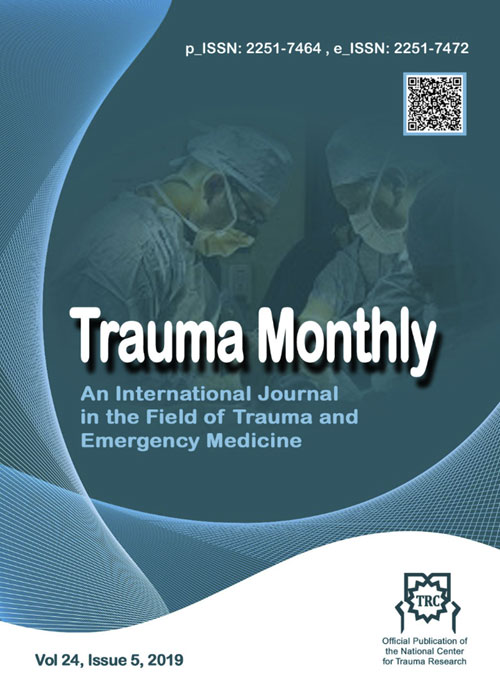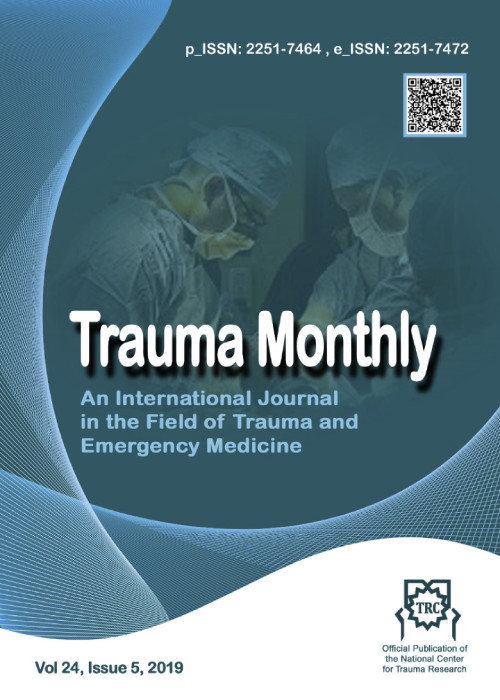فهرست مطالب

Trauma Monthly
Volume:27 Issue: 4, Jul-Aug 2022
- تاریخ انتشار: 1401/06/23
- تعداد عناوین: 7
-
-
Pages 513-516
Wandering spleen is a condition in which the spleen migrates to another position in the abdomen different from its normal location. In this study, we present two different cases of wandering spleen admitted in Loghman Hakim government hospital in Tehran, Iran. The cases included a 5-year-old girl with wandering spleen and complication of torsion and infarction of spleen and a 24-year-old man with wandering spleen and intestinal malrotation. The three entities, wandering spleen, gastric volvulus, and intestinal malrotation are not common and can occur independently, but share a common etiology as congenital anomalous intraperitoneal visceral attachment originated from the dorsal mesentery. Wandering spleen may cause abdominal pain and then become complicated by torsion and infarct.
Keywords: Wandering Spleen, spleen, Abdomen -
Pages 517-522BackgroundAcetabular fracture surgery may be associated with complications such as blood loss during and after surgery, which can lead to increased morbidity and mortality. Tranexamic acid (TXA) reduces bleeding by reducing local fibrinolysis. This study aimed to evaluate the efficacy of TXA in reducing transfusion and blood loss in acetabular fracture surgery.MethodsOverall 51 patients were randomly divided into two groups TXA and control. Preoperative and postoperative hemoglobin, intraoperative and postoperative bleeding volume, as well as deep vein thrombosis (DVT) symptoms, were recorded in both groups.ResultsOut of 51 patients, 41 (80.4%) were male, and 10 (19.6%) were female. Bleeding volume during surgery was 386.53±76.88 in the TXA group and 854.00±369.94 in the control group, indicating a significant difference (P<0.001). Also, 21 patients underwent packed cell transfusion, of whom19 were in the control group and two in the TXA group (P<0.001). The mean duration of surgery was 125.38±14.41 minutes in the TXA group and 156.40±16.74 minutes in the control group (P <0.001). Postoperative bleeding volume was reported as 105.76± 51.62 in the TXA group and 230.00± 47.87 in the control group (P<0.001). Furthermore, TXA did not increase the incidence of DVT.ConclusionIntravenous injection of TXA in acetabular fractures significantly reduced the need for blood transfusions, blood loss, and duration of surgery. Meanwhile, it did not increase the risk of DVT.Keywords: Acetabular Fracture, Tranexamic acid, transfusion
-
Pages 523-531Background
The extent and severity of injury distribution can determine the patient's mortality and morbidity. This study aimed to determine the pattern and role of different variables in injury distribution and outcome among trauma patients.
MethodsThis retrospective cohort study was performed in the largest trauma center in the south of Iran, Shiraz, in 2020. All the trauma patients aged above 15 years who were assigned to levels I and II based on the Canadian Triage and Acuity System (CTAS) triage system were categorized as S.00 to T79.7 in the International Statistical Classification of Diseases and Related Health Problems (ICD).
ResultsOverall, 1309 patients were assessed. Thorax injury had the highest association with other body injuries in patients with multiple trauma. Head and neck injuries were more associated with chest injuries (40%). Facial and limb injuries were highly associated with Thorax (30%, 38%) and head and neck injuries (41%, 32%), respectively. The analysis of injury distribution showed that the chest is the most commonly injured site (31%) in patients with car accidents. Head and neck injuries are the prevalent site of injury in motorcycle riders (33%). Head, neck, chest, and limb injuries were relatively similar (27%) in pedestrian accidents.
ConclusionThe body injury pattern can vary depending on the cause. It is necessary to take the patient's history during a thorough examination and perform paraclinical tests such as ultrasound and CT scan to prevent the diagnosis of missing injuries.
Keywords: Multiple Trauma, Distribution, Wound, Injury -
Pages 532-537BackgroundThe fractional excretion of exhaled nitric oxide (FeNO) has been proposed as a noninvasive measure of airway inflammation. FeNO levels were assessed in this study to evaluate airway inflammatory characteristics in mustard airway disease (MAD).MethodsThirty-three MAD patients were involved in the study to determine the level of exhaled nitric oxide (NO) and its relationship to lung function; 16 MAD patients with normal symptoms and 17 MAD patients with severe symptoms were identified from this sample. To regulate their condition, severe individuals were given inhaled corticosteroids.ResultsExhaled NO levels were greater in severe patients than in normal patients, but this was not significant. Furthermore, the findings revealed that FeNO concentrations were positively linked with carbon monoxide transfer factor in the severe group (TLCO). We were unable to find a link between pulmonary volumes and FeNO levels. We also found that 17% of patients in the severe category had FeNO levels greater than 40 ppb (cutoff point of FeNO for patients with asthma). Although, the severe group's usage of inhaled corticosteroids may lower FeNO levels.ConclusionBased on the FeNO results, we conclude that MAD is a diverse disorder. Exhaled NO was found to be able to detect the asthma phenotype in MAD, and FeNO was found to be a beneficial supplement to aid lung function during MAD evaluation. FeNO levels in MAD patients were similar to those in COPD patients.Keywords: exhaled nitric oxide, Mustard airway disease, Asthma phenotype, Mustard gas, FeNO
-
Pages 539-542Background
Traumatic brain injury (TBI) is one of the causes of death wherein thyroid hormone concentrations are abnormally altered. This study aimed to assess thyroid function tests and the effect of levothyroxine on TBI and its outcome.
MethodsIn this randomized clinical trial study, the TBI group Levothyroxine (50 mg) was administered twice daily for three days; the control group received a placebo in a similar pattern. The serum levels of T3, T4, and TSH were evaluated in 100 TBI patients on days 1 and 7. A questionnaire related to Disability was assessed using both Disability Rating Scale (DRS) and Glasgow Outcome Scale (GOS) scores. The obtained data were analyzed by SPSS version 20.
ResultsThe mean levels of T3 and TSH in both groups were not significantly different. T4 levels of the patients receiving levothyroxine were significantly higher than the control group. The mean DRS scores at the time of discharge were lower in the levothyroxine group compared to the placebo group.
ConclusionOur results showed that levothyroxine is effective in improving patients suffering moderate head trauma. Furthermore, the T4 serum level can be used as a prognostic factor in these patients.
Keywords: Traumatic Brain Injury, levothyroxine, Glasgow coma scale, Glasgow Outcome Scale, Mortality rate -
Pages 543-551BackgroundThis study aimed to compare pulse pressure and pulse oximetry fluctuations in predicting the response to fluid therapy and find a noninvasive method to monitor intravascular volume in traumatic patients on ventilators.MethodForty hypotensive severe multiple trauma patients under mechanical ventilation were enrolled in this cross-sectional study. Based on cardiac index (CI) changes in response to 500-mL normal saline administration, patients were divided into two groups of responders and non-responders (each with 20 subjects). Mean arterial pressure (MAP), diastolic blood pressure (DBP), systolic blood pressure (SBP), heart rate (HR), pulse pressure variation (PPV), and respiratory variations in pulse oximetry plethysmographic waveform amplitude (ΔPOP) were compared before and after the intervention.ResultsThe mean age of patients (22 males and 18 females) was 44.8 ± 15.4 years, who were divided into two groups: responder and non-responder to liquid. Following fluid therapy, SBP, DBP, and MAP only significantly increased in the responder group, while PPV and ΔPOP significantly decreased (P < 0.05). Also, PPV and ΔPOP significantly correlated before and after the intervention in the study groups (P < 0.05).DiscussionThis study demonstrated that ΔPOP, as PPV monitoring, can predict fluid responsiveness and volume status in hypotensive multiple trauma patients under controlled mechanical ventilation.Keywords: pulse oximetry, Trauma, pressure, Fluid Therapy, intensive care
-
Pages 552-556Background
Ankle sprains are amongst the most common sports injuries. Our study aimed to evaluate the results of arthroscopic surgery of detachable osteochondritis lesions in the talus (OLT) following rotational trauma in military patients referred to us.
MethodsWe assessed 120 patients referred to our Hospital from June 2021 to June 2021 due to detached osteochondritis lesions in the talus of the foot. The lesion was due to rotational trauma and ankle sprain. Time to return to activity, ATFL rupture, PTFL rupture, OS trigonum, rupture of the lower desperation CFL, Loose body, and location were compared.
ResultsOut of 120 patients, 107 (89.2%) were male. The mean age of the patients was 38.17±12.70 years. The mean time to return to activity was 108.07±27.87 days in women and 92.89±25.56 days in men (P = 0.066). ATFL rupture was 11 (84.6%) in women and 48 (44.9%) (P = 0.007). Lower syndesmosis was 8 (61.5%) in women and 30 (28.0%) (P = 0.014). The mean time to return to activity in patients <45 years was 87.54±23.59, and in patients >45 years was 114.51±22.81 days (P = 0.0001). There was no significant difference in the distribution of ATFL rupture, PTFL rupture.
ConclusionThe results of this study showed that the mean time to return to activity in female patients was longer than in males. Also, the return time to activity in patients less than 45 years was less than in patients over 45 years. The rupture of ATFL, and inferior Syndesmosis was higher in female than male patients.
Keywords: Arthroscopic Surgery, Detachable Osteochondritis Lesion, talus


